Systematic Review: Strategies for Improving Nutrition Globally
VerifiedAdded on 2023/01/20
|10
|2038
|31
Report
AI Summary
This systematic review examines the critical issue of improving nutrition globally, addressing the challenges of malnutrition, undernutrition, and overnutrition. The study explores the impact of unhealthy eating habits on public health, including the rise of chronic diseases like hypertension and type-2 diabetes, especially among younger generations. The review highlights the importance of a balanced diet, integrating macronutrients and micronutrients, and the need for comprehensive strategies to combat nutritional imbalances. It presents data on the prevalence of malnutrition worldwide, referencing WHO reports, and emphasizes the vulnerability of specific populations, such as women, children, and those in poverty. The methodology includes a search of multiple electronic databases, focusing on English language publications from 2014 to the present, using keywords like "nutrient" and "malnutrition." The review aims to contribute to a better understanding of nutrition improvement and assist researchers and policymakers in targeting populations in underdeveloped and developing countries. The conclusion emphasizes the importance of collaborative efforts to improve the accessibility, affordability, and availability of healthy diets, supported by evidence-informed guidelines and effective action plans.
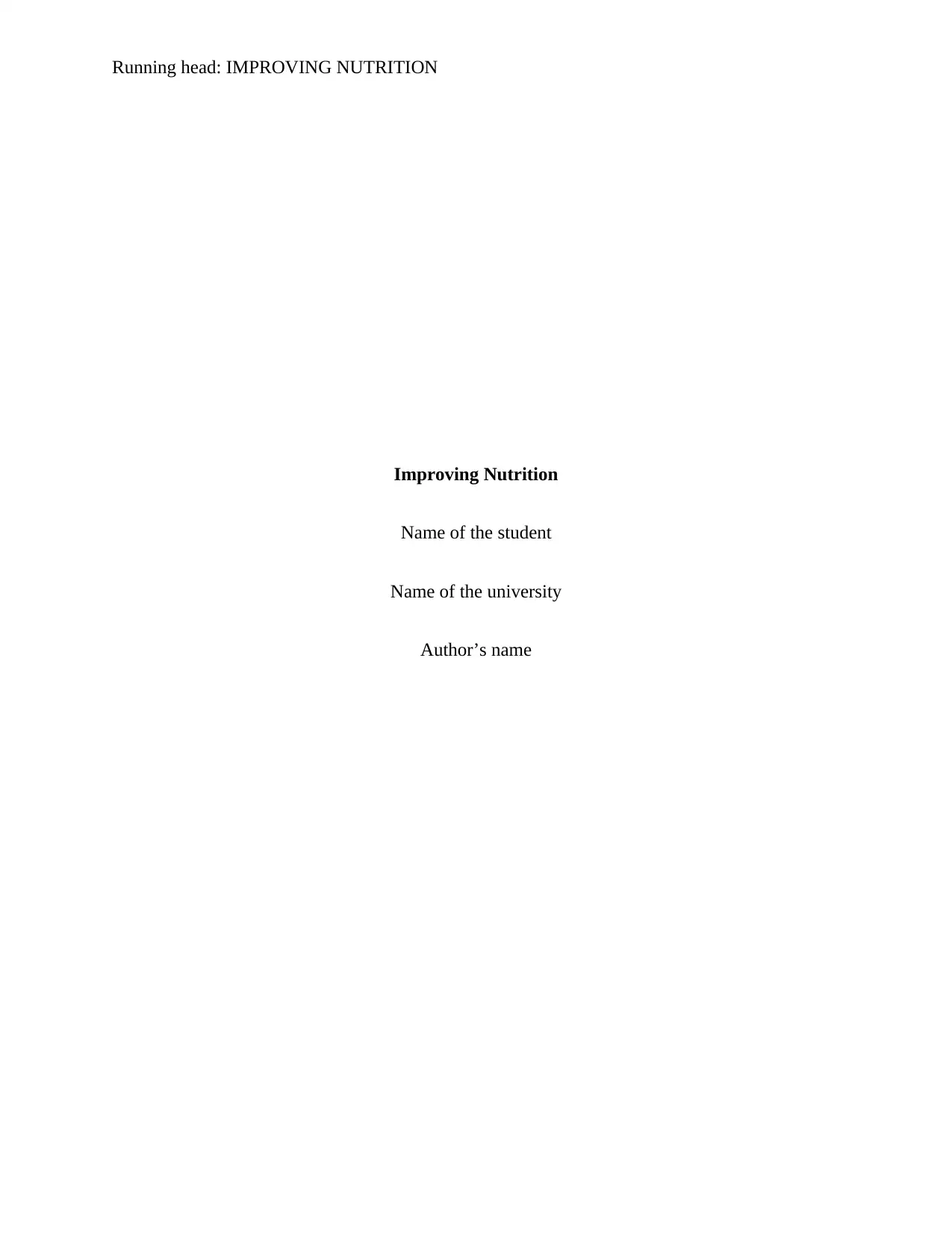
Running head: IMPROVING NUTRITION
Improving Nutrition
Name of the student
Name of the university
Author’s name
Improving Nutrition
Name of the student
Name of the university
Author’s name
Paraphrase This Document
Need a fresh take? Get an instant paraphrase of this document with our AI Paraphraser

1IMPROVING NUTRITION
STUDY OBJECTIVE
The unhealthy eating habits have contributed to the obesity and many other health issues
throughout the world. Even if individuals who have a healthy weight, an unhealthy diet is related
to many health issues which can cause several types of diseases and even can become a reason
for death. According to a survey conducted by WHO in the recent years the younger generation
people are experiencing chronic diseases like hypertension and type-2 diabetes due to the
consumption of unhealthy food.
Good and healthy diet always comprise of healthy nutrition which helps in promoting a healthy
lifestyle. If a healthy diet is integrated with the physical activities, then an individual’s diet can
help in reaching a healthy weight, a proper physical shape and also will help in reducing the risks
of any diseases. The prime objective of systematic review is to:
To increase the availability and improve the nutrient level of food ingredients and food
items for developing a healthy population.
To integrate different national, international administrations and NGOs devoted to the
health of population.
To share knowledge and educate individuals and community-based stakeholders on the
benefits of health and nutritional food in the development of a healthy population.
STUDY OBJECTIVE
The unhealthy eating habits have contributed to the obesity and many other health issues
throughout the world. Even if individuals who have a healthy weight, an unhealthy diet is related
to many health issues which can cause several types of diseases and even can become a reason
for death. According to a survey conducted by WHO in the recent years the younger generation
people are experiencing chronic diseases like hypertension and type-2 diabetes due to the
consumption of unhealthy food.
Good and healthy diet always comprise of healthy nutrition which helps in promoting a healthy
lifestyle. If a healthy diet is integrated with the physical activities, then an individual’s diet can
help in reaching a healthy weight, a proper physical shape and also will help in reducing the risks
of any diseases. The prime objective of systematic review is to:
To increase the availability and improve the nutrient level of food ingredients and food
items for developing a healthy population.
To integrate different national, international administrations and NGOs devoted to the
health of population.
To share knowledge and educate individuals and community-based stakeholders on the
benefits of health and nutritional food in the development of a healthy population.
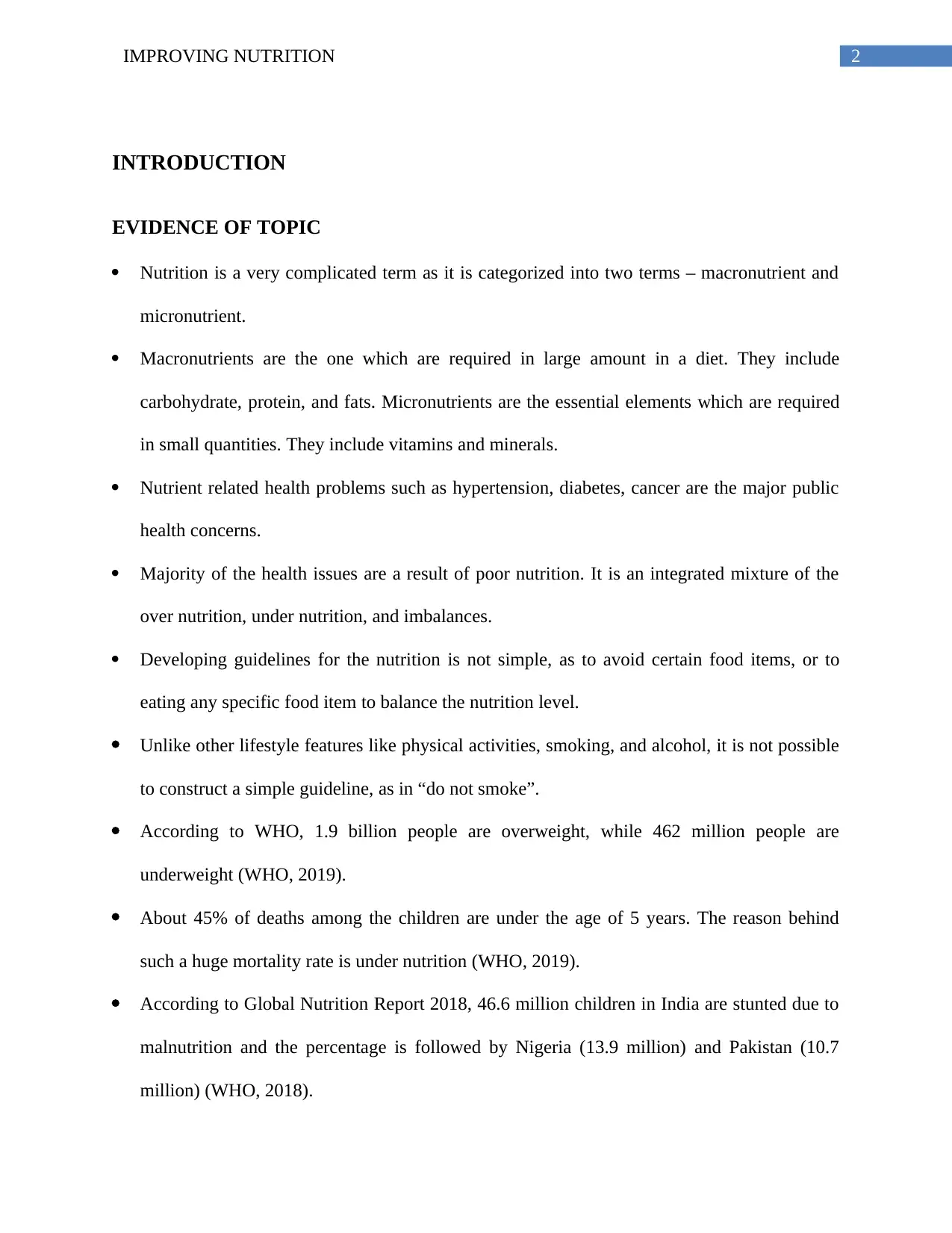
2IMPROVING NUTRITION
INTRODUCTION
EVIDENCE OF TOPIC
Nutrition is a very complicated term as it is categorized into two terms – macronutrient and
micronutrient.
Macronutrients are the one which are required in large amount in a diet. They include
carbohydrate, protein, and fats. Micronutrients are the essential elements which are required
in small quantities. They include vitamins and minerals.
Nutrient related health problems such as hypertension, diabetes, cancer are the major public
health concerns.
Majority of the health issues are a result of poor nutrition. It is an integrated mixture of the
over nutrition, under nutrition, and imbalances.
Developing guidelines for the nutrition is not simple, as to avoid certain food items, or to
eating any specific food item to balance the nutrition level.
Unlike other lifestyle features like physical activities, smoking, and alcohol, it is not possible
to construct a simple guideline, as in “do not smoke”.
According to WHO, 1.9 billion people are overweight, while 462 million people are
underweight (WHO, 2019).
About 45% of deaths among the children are under the age of 5 years. The reason behind
such a huge mortality rate is under nutrition (WHO, 2019).
According to Global Nutrition Report 2018, 46.6 million children in India are stunted due to
malnutrition and the percentage is followed by Nigeria (13.9 million) and Pakistan (10.7
million) (WHO, 2018).
INTRODUCTION
EVIDENCE OF TOPIC
Nutrition is a very complicated term as it is categorized into two terms – macronutrient and
micronutrient.
Macronutrients are the one which are required in large amount in a diet. They include
carbohydrate, protein, and fats. Micronutrients are the essential elements which are required
in small quantities. They include vitamins and minerals.
Nutrient related health problems such as hypertension, diabetes, cancer are the major public
health concerns.
Majority of the health issues are a result of poor nutrition. It is an integrated mixture of the
over nutrition, under nutrition, and imbalances.
Developing guidelines for the nutrition is not simple, as to avoid certain food items, or to
eating any specific food item to balance the nutrition level.
Unlike other lifestyle features like physical activities, smoking, and alcohol, it is not possible
to construct a simple guideline, as in “do not smoke”.
According to WHO, 1.9 billion people are overweight, while 462 million people are
underweight (WHO, 2019).
About 45% of deaths among the children are under the age of 5 years. The reason behind
such a huge mortality rate is under nutrition (WHO, 2019).
According to Global Nutrition Report 2018, 46.6 million children in India are stunted due to
malnutrition and the percentage is followed by Nigeria (13.9 million) and Pakistan (10.7
million) (WHO, 2018).
⊘ This is a preview!⊘
Do you want full access?
Subscribe today to unlock all pages.

Trusted by 1+ million students worldwide

3IMPROVING NUTRITION
Prevalence of the obese children is more in upper-middle economic nations and low in the
low economic nations (Rojer et al., 2016).
Women, infants, children and adults are at the most danger of malnutrition. Poverty just
amplifies the risk of malnutrition (WHO, 2019).
Patients who are on hemodialysis generally face inflammation, and atherosclerosis and
majority of such problems occurs due to malnutrition (Kwant, Ruiter & Noordegraaf, 2019).
What motivated this review?
Issues related to nutrition such as the over nutrition, under nutrition, and imbalances occur all
over the world. This is particularly true for underdeveloped countries, developing countries, rural
areas in the tropical and subtropical countries where lack of daily food has become a common
scenario. There are many research studies on the incidence of over nutrition, under nutrition, and
imbalances and need for improvement of nutrition for the development of health, however, there
are hardly any systematic reviews on improving the nutrition level. Hence, this review would
contribute in the better understanding of the necessity of nutrition and would help the researchers
and policy makers to target the population of places such as underdeveloped or developing
countries for improving the nutrition for the betterment of the health of the population.
Prevalence of the obese children is more in upper-middle economic nations and low in the
low economic nations (Rojer et al., 2016).
Women, infants, children and adults are at the most danger of malnutrition. Poverty just
amplifies the risk of malnutrition (WHO, 2019).
Patients who are on hemodialysis generally face inflammation, and atherosclerosis and
majority of such problems occurs due to malnutrition (Kwant, Ruiter & Noordegraaf, 2019).
What motivated this review?
Issues related to nutrition such as the over nutrition, under nutrition, and imbalances occur all
over the world. This is particularly true for underdeveloped countries, developing countries, rural
areas in the tropical and subtropical countries where lack of daily food has become a common
scenario. There are many research studies on the incidence of over nutrition, under nutrition, and
imbalances and need for improvement of nutrition for the development of health, however, there
are hardly any systematic reviews on improving the nutrition level. Hence, this review would
contribute in the better understanding of the necessity of nutrition and would help the researchers
and policy makers to target the population of places such as underdeveloped or developing
countries for improving the nutrition for the betterment of the health of the population.
Paraphrase This Document
Need a fresh take? Get an instant paraphrase of this document with our AI Paraphraser
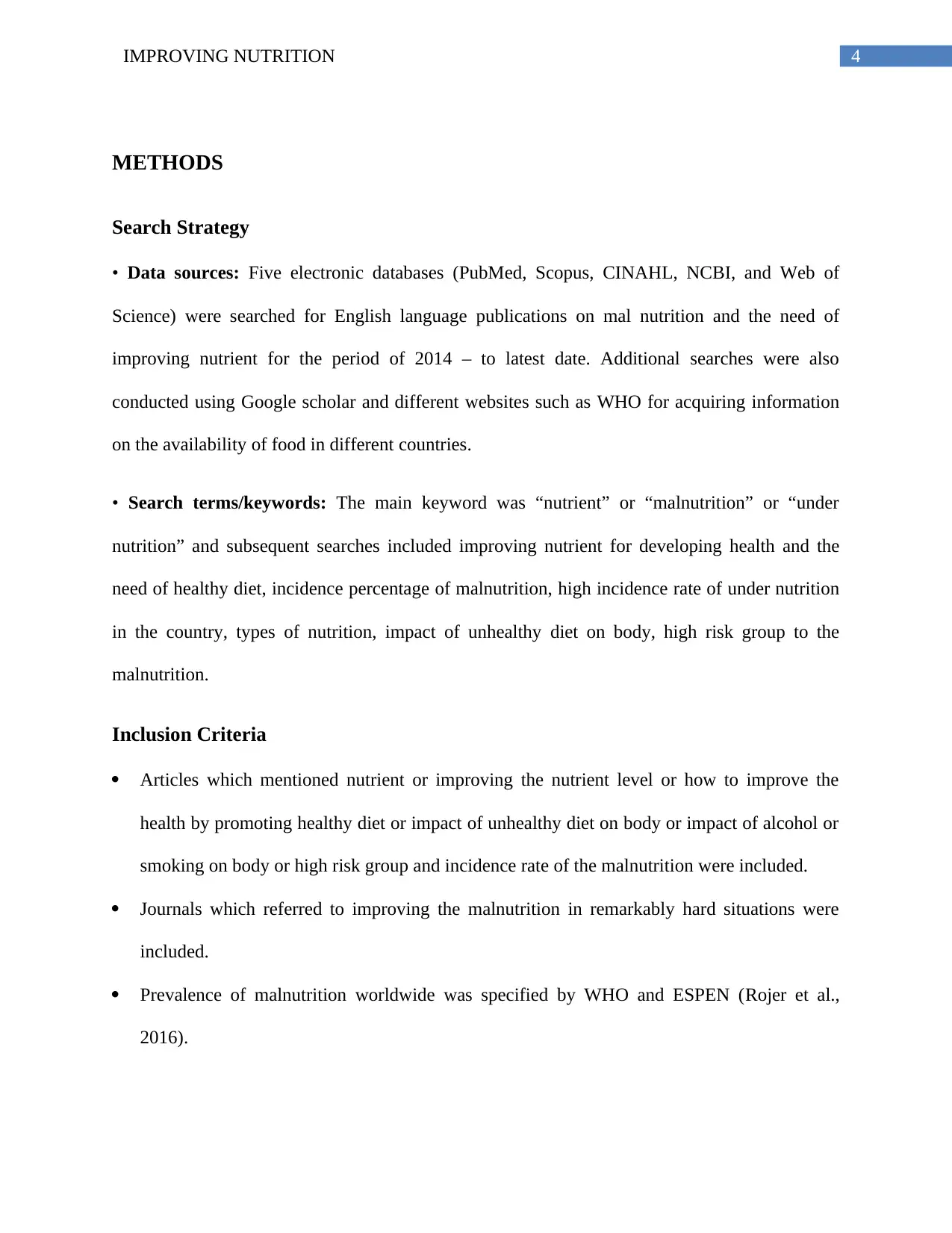
4IMPROVING NUTRITION
METHODS
Search Strategy
• Data sources: Five electronic databases (PubMed, Scopus, CINAHL, NCBI, and Web of
Science) were searched for English language publications on mal nutrition and the need of
improving nutrient for the period of 2014 – to latest date. Additional searches were also
conducted using Google scholar and different websites such as WHO for acquiring information
on the availability of food in different countries.
• Search terms/keywords: The main keyword was “nutrient” or “malnutrition” or “under
nutrition” and subsequent searches included improving nutrient for developing health and the
need of healthy diet, incidence percentage of malnutrition, high incidence rate of under nutrition
in the country, types of nutrition, impact of unhealthy diet on body, high risk group to the
malnutrition.
Inclusion Criteria
Articles which mentioned nutrient or improving the nutrient level or how to improve the
health by promoting healthy diet or impact of unhealthy diet on body or impact of alcohol or
smoking on body or high risk group and incidence rate of the malnutrition were included.
Journals which referred to improving the malnutrition in remarkably hard situations were
included.
Prevalence of malnutrition worldwide was specified by WHO and ESPEN (Rojer et al.,
2016).
METHODS
Search Strategy
• Data sources: Five electronic databases (PubMed, Scopus, CINAHL, NCBI, and Web of
Science) were searched for English language publications on mal nutrition and the need of
improving nutrient for the period of 2014 – to latest date. Additional searches were also
conducted using Google scholar and different websites such as WHO for acquiring information
on the availability of food in different countries.
• Search terms/keywords: The main keyword was “nutrient” or “malnutrition” or “under
nutrition” and subsequent searches included improving nutrient for developing health and the
need of healthy diet, incidence percentage of malnutrition, high incidence rate of under nutrition
in the country, types of nutrition, impact of unhealthy diet on body, high risk group to the
malnutrition.
Inclusion Criteria
Articles which mentioned nutrient or improving the nutrient level or how to improve the
health by promoting healthy diet or impact of unhealthy diet on body or impact of alcohol or
smoking on body or high risk group and incidence rate of the malnutrition were included.
Journals which referred to improving the malnutrition in remarkably hard situations were
included.
Prevalence of malnutrition worldwide was specified by WHO and ESPEN (Rojer et al.,
2016).
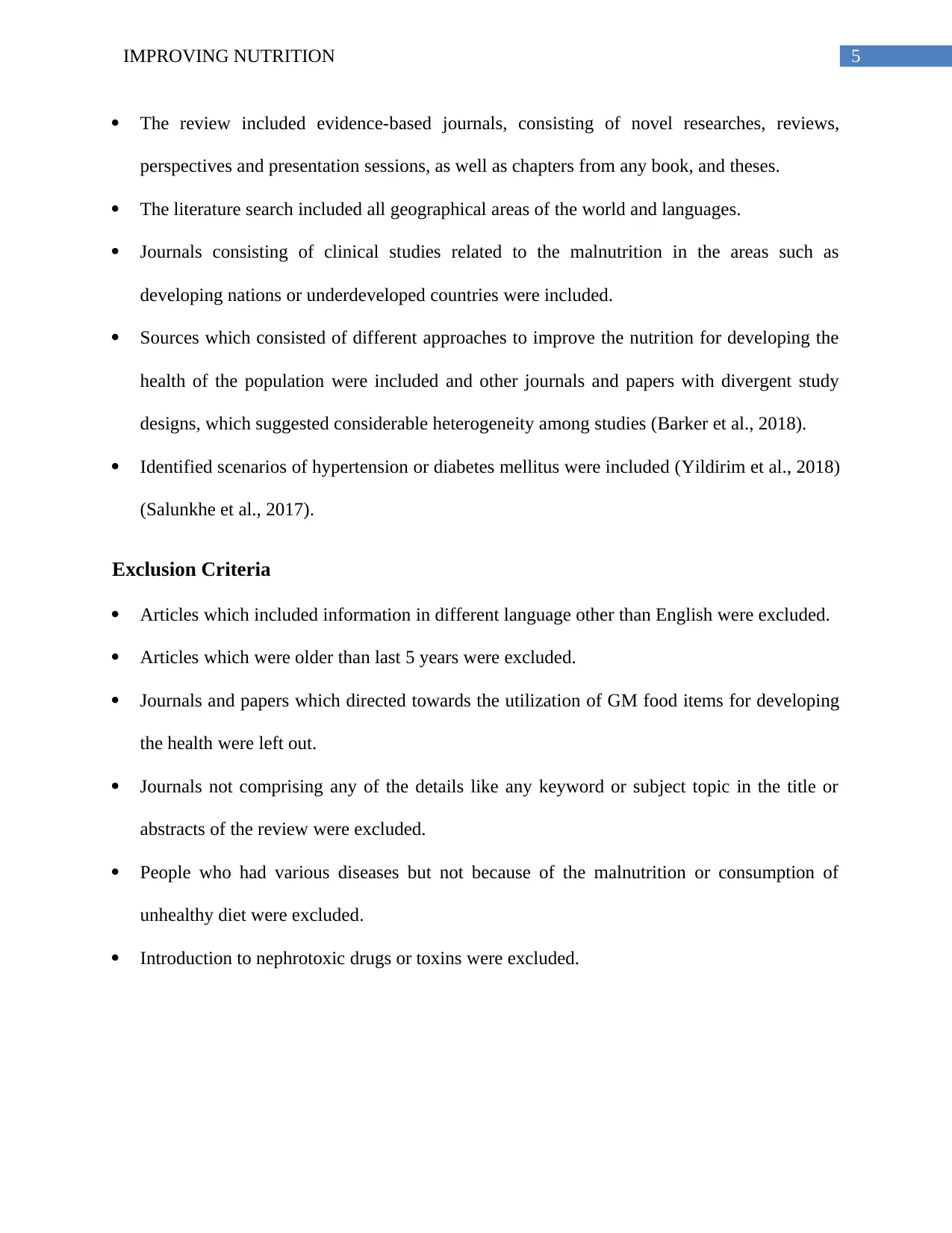
5IMPROVING NUTRITION
The review included evidence-based journals, consisting of novel researches, reviews,
perspectives and presentation sessions, as well as chapters from any book, and theses.
The literature search included all geographical areas of the world and languages.
Journals consisting of clinical studies related to the malnutrition in the areas such as
developing nations or underdeveloped countries were included.
Sources which consisted of different approaches to improve the nutrition for developing the
health of the population were included and other journals and papers with divergent study
designs, which suggested considerable heterogeneity among studies (Barker et al., 2018).
Identified scenarios of hypertension or diabetes mellitus were included (Yildirim et al., 2018)
(Salunkhe et al., 2017).
Exclusion Criteria
Articles which included information in different language other than English were excluded.
Articles which were older than last 5 years were excluded.
Journals and papers which directed towards the utilization of GM food items for developing
the health were left out.
Journals not comprising any of the details like any keyword or subject topic in the title or
abstracts of the review were excluded.
People who had various diseases but not because of the malnutrition or consumption of
unhealthy diet were excluded.
Introduction to nephrotoxic drugs or toxins were excluded.
The review included evidence-based journals, consisting of novel researches, reviews,
perspectives and presentation sessions, as well as chapters from any book, and theses.
The literature search included all geographical areas of the world and languages.
Journals consisting of clinical studies related to the malnutrition in the areas such as
developing nations or underdeveloped countries were included.
Sources which consisted of different approaches to improve the nutrition for developing the
health of the population were included and other journals and papers with divergent study
designs, which suggested considerable heterogeneity among studies (Barker et al., 2018).
Identified scenarios of hypertension or diabetes mellitus were included (Yildirim et al., 2018)
(Salunkhe et al., 2017).
Exclusion Criteria
Articles which included information in different language other than English were excluded.
Articles which were older than last 5 years were excluded.
Journals and papers which directed towards the utilization of GM food items for developing
the health were left out.
Journals not comprising any of the details like any keyword or subject topic in the title or
abstracts of the review were excluded.
People who had various diseases but not because of the malnutrition or consumption of
unhealthy diet were excluded.
Introduction to nephrotoxic drugs or toxins were excluded.
⊘ This is a preview!⊘
Do you want full access?
Subscribe today to unlock all pages.

Trusted by 1+ million students worldwide
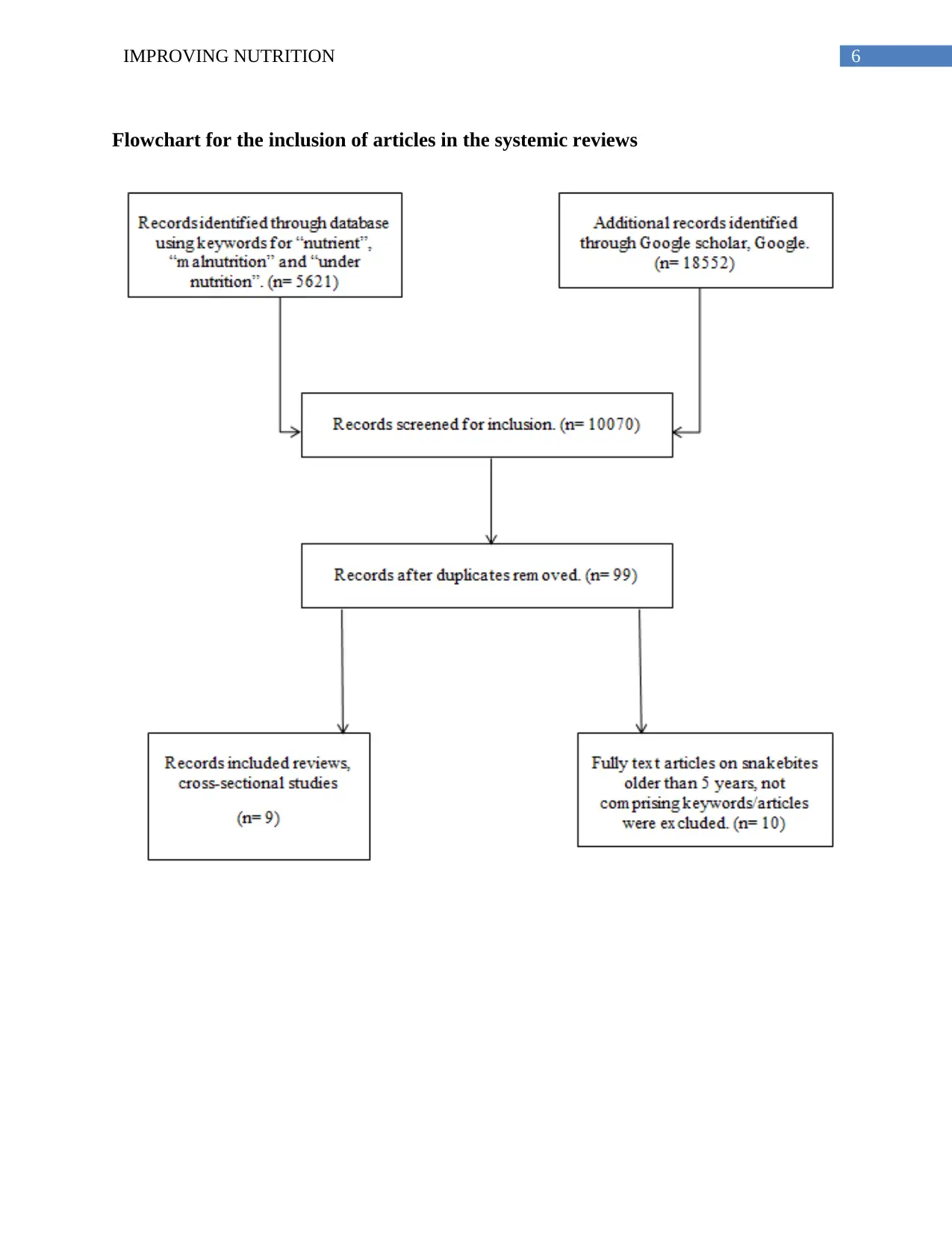
6IMPROVING NUTRITION
Flowchart for the inclusion of articles in the systemic reviews
Flowchart for the inclusion of articles in the systemic reviews
Paraphrase This Document
Need a fresh take? Get an instant paraphrase of this document with our AI Paraphraser
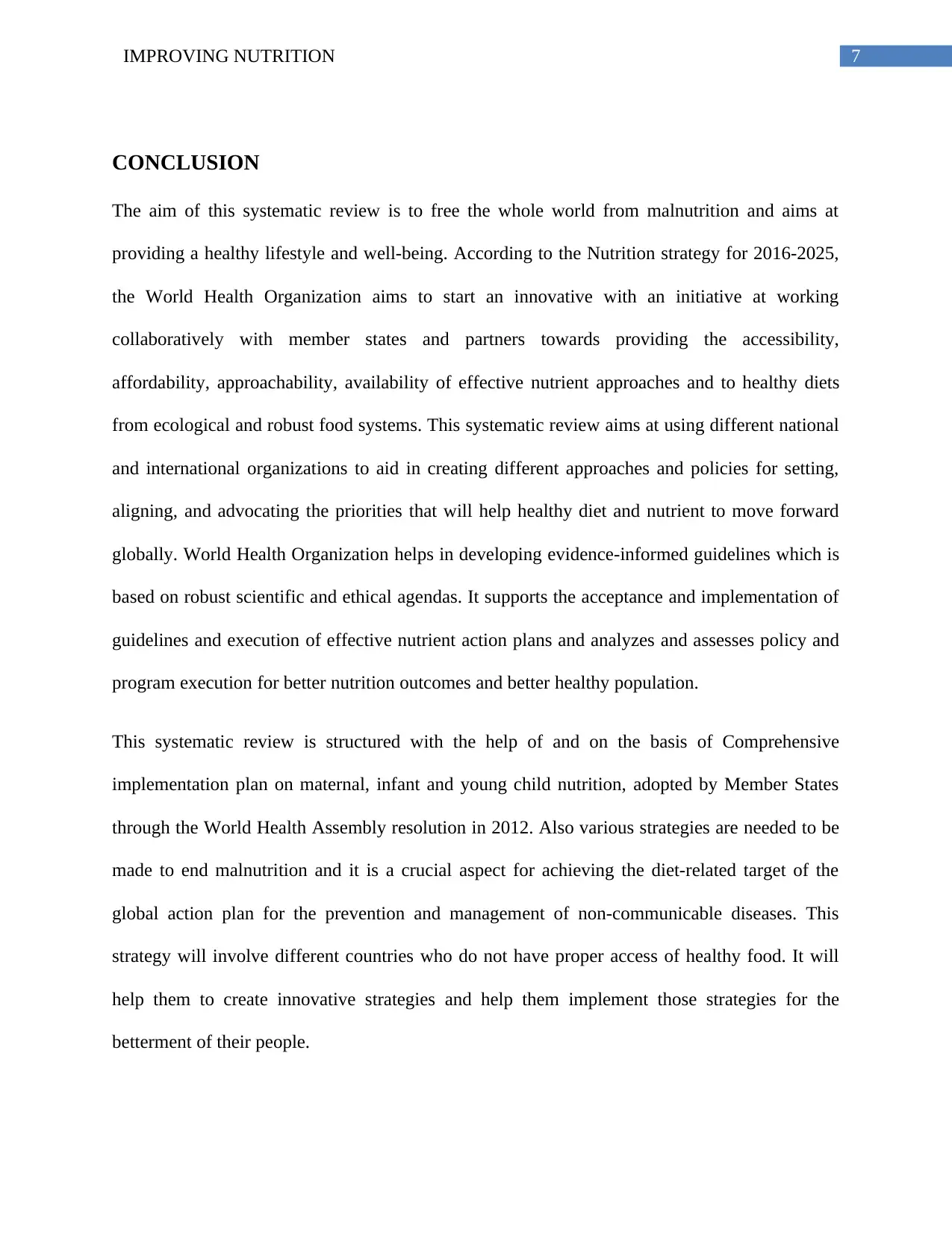
7IMPROVING NUTRITION
CONCLUSION
The aim of this systematic review is to free the whole world from malnutrition and aims at
providing a healthy lifestyle and well-being. According to the Nutrition strategy for 2016-2025,
the World Health Organization aims to start an innovative with an initiative at working
collaboratively with member states and partners towards providing the accessibility,
affordability, approachability, availability of effective nutrient approaches and to healthy diets
from ecological and robust food systems. This systematic review aims at using different national
and international organizations to aid in creating different approaches and policies for setting,
aligning, and advocating the priorities that will help healthy diet and nutrient to move forward
globally. World Health Organization helps in developing evidence-informed guidelines which is
based on robust scientific and ethical agendas. It supports the acceptance and implementation of
guidelines and execution of effective nutrient action plans and analyzes and assesses policy and
program execution for better nutrition outcomes and better healthy population.
This systematic review is structured with the help of and on the basis of Comprehensive
implementation plan on maternal, infant and young child nutrition, adopted by Member States
through the World Health Assembly resolution in 2012. Also various strategies are needed to be
made to end malnutrition and it is a crucial aspect for achieving the diet-related target of the
global action plan for the prevention and management of non-communicable diseases. This
strategy will involve different countries who do not have proper access of healthy food. It will
help them to create innovative strategies and help them implement those strategies for the
betterment of their people.
CONCLUSION
The aim of this systematic review is to free the whole world from malnutrition and aims at
providing a healthy lifestyle and well-being. According to the Nutrition strategy for 2016-2025,
the World Health Organization aims to start an innovative with an initiative at working
collaboratively with member states and partners towards providing the accessibility,
affordability, approachability, availability of effective nutrient approaches and to healthy diets
from ecological and robust food systems. This systematic review aims at using different national
and international organizations to aid in creating different approaches and policies for setting,
aligning, and advocating the priorities that will help healthy diet and nutrient to move forward
globally. World Health Organization helps in developing evidence-informed guidelines which is
based on robust scientific and ethical agendas. It supports the acceptance and implementation of
guidelines and execution of effective nutrient action plans and analyzes and assesses policy and
program execution for better nutrition outcomes and better healthy population.
This systematic review is structured with the help of and on the basis of Comprehensive
implementation plan on maternal, infant and young child nutrition, adopted by Member States
through the World Health Assembly resolution in 2012. Also various strategies are needed to be
made to end malnutrition and it is a crucial aspect for achieving the diet-related target of the
global action plan for the prevention and management of non-communicable diseases. This
strategy will involve different countries who do not have proper access of healthy food. It will
help them to create innovative strategies and help them implement those strategies for the
betterment of their people.
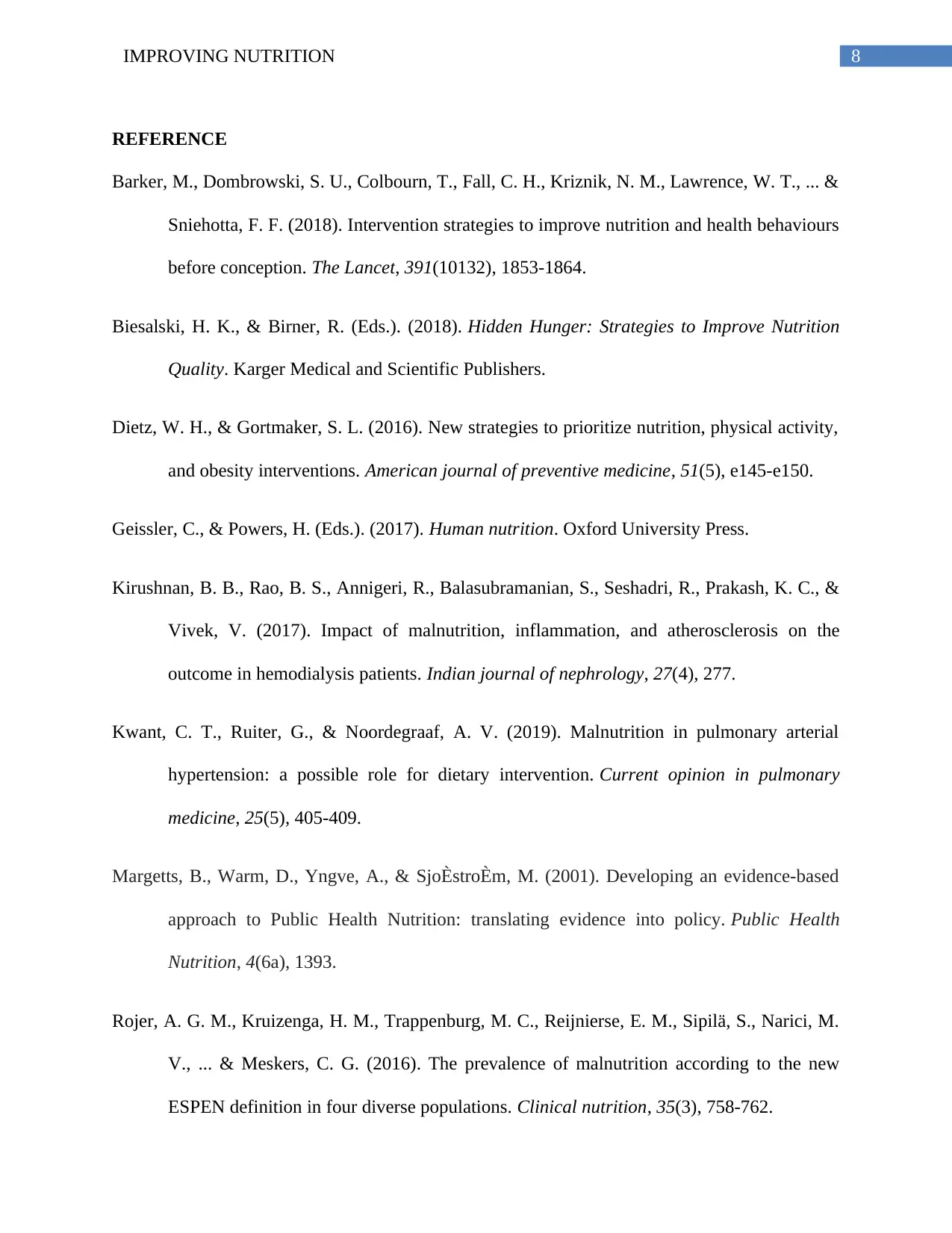
8IMPROVING NUTRITION
REFERENCE
Barker, M., Dombrowski, S. U., Colbourn, T., Fall, C. H., Kriznik, N. M., Lawrence, W. T., ... &
Sniehotta, F. F. (2018). Intervention strategies to improve nutrition and health behaviours
before conception. The Lancet, 391(10132), 1853-1864.
Biesalski, H. K., & Birner, R. (Eds.). (2018). Hidden Hunger: Strategies to Improve Nutrition
Quality. Karger Medical and Scientific Publishers.
Dietz, W. H., & Gortmaker, S. L. (2016). New strategies to prioritize nutrition, physical activity,
and obesity interventions. American journal of preventive medicine, 51(5), e145-e150.
Geissler, C., & Powers, H. (Eds.). (2017). Human nutrition. Oxford University Press.
Kirushnan, B. B., Rao, B. S., Annigeri, R., Balasubramanian, S., Seshadri, R., Prakash, K. C., &
Vivek, V. (2017). Impact of malnutrition, inflammation, and atherosclerosis on the
outcome in hemodialysis patients. Indian journal of nephrology, 27(4), 277.
Kwant, C. T., Ruiter, G., & Noordegraaf, A. V. (2019). Malnutrition in pulmonary arterial
hypertension: a possible role for dietary intervention. Current opinion in pulmonary
medicine, 25(5), 405-409.
Margetts, B., Warm, D., Yngve, A., & SjoÈstroÈm, M. (2001). Developing an evidence-based
approach to Public Health Nutrition: translating evidence into policy. Public Health
Nutrition, 4(6a), 1393.
Rojer, A. G. M., Kruizenga, H. M., Trappenburg, M. C., Reijnierse, E. M., Sipilä, S., Narici, M.
V., ... & Meskers, C. G. (2016). The prevalence of malnutrition according to the new
ESPEN definition in four diverse populations. Clinical nutrition, 35(3), 758-762.
REFERENCE
Barker, M., Dombrowski, S. U., Colbourn, T., Fall, C. H., Kriznik, N. M., Lawrence, W. T., ... &
Sniehotta, F. F. (2018). Intervention strategies to improve nutrition and health behaviours
before conception. The Lancet, 391(10132), 1853-1864.
Biesalski, H. K., & Birner, R. (Eds.). (2018). Hidden Hunger: Strategies to Improve Nutrition
Quality. Karger Medical and Scientific Publishers.
Dietz, W. H., & Gortmaker, S. L. (2016). New strategies to prioritize nutrition, physical activity,
and obesity interventions. American journal of preventive medicine, 51(5), e145-e150.
Geissler, C., & Powers, H. (Eds.). (2017). Human nutrition. Oxford University Press.
Kirushnan, B. B., Rao, B. S., Annigeri, R., Balasubramanian, S., Seshadri, R., Prakash, K. C., &
Vivek, V. (2017). Impact of malnutrition, inflammation, and atherosclerosis on the
outcome in hemodialysis patients. Indian journal of nephrology, 27(4), 277.
Kwant, C. T., Ruiter, G., & Noordegraaf, A. V. (2019). Malnutrition in pulmonary arterial
hypertension: a possible role for dietary intervention. Current opinion in pulmonary
medicine, 25(5), 405-409.
Margetts, B., Warm, D., Yngve, A., & SjoÈstroÈm, M. (2001). Developing an evidence-based
approach to Public Health Nutrition: translating evidence into policy. Public Health
Nutrition, 4(6a), 1393.
Rojer, A. G. M., Kruizenga, H. M., Trappenburg, M. C., Reijnierse, E. M., Sipilä, S., Narici, M.
V., ... & Meskers, C. G. (2016). The prevalence of malnutrition according to the new
ESPEN definition in four diverse populations. Clinical nutrition, 35(3), 758-762.
⊘ This is a preview!⊘
Do you want full access?
Subscribe today to unlock all pages.

Trusted by 1+ million students worldwide
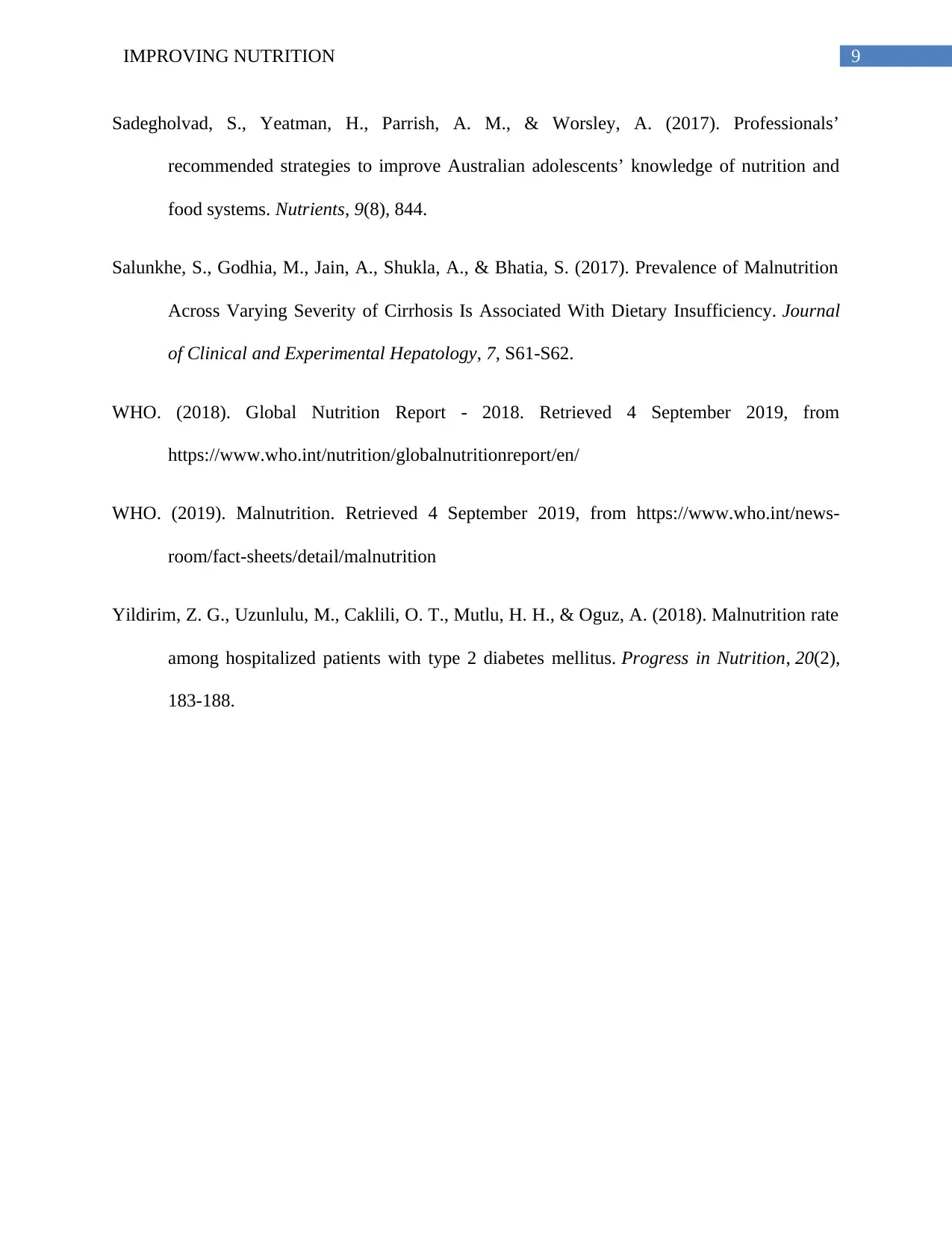
9IMPROVING NUTRITION
Sadegholvad, S., Yeatman, H., Parrish, A. M., & Worsley, A. (2017). Professionals’
recommended strategies to improve Australian adolescents’ knowledge of nutrition and
food systems. Nutrients, 9(8), 844.
Salunkhe, S., Godhia, M., Jain, A., Shukla, A., & Bhatia, S. (2017). Prevalence of Malnutrition
Across Varying Severity of Cirrhosis Is Associated With Dietary Insufficiency. Journal
of Clinical and Experimental Hepatology, 7, S61-S62.
WHO. (2018). Global Nutrition Report - 2018. Retrieved 4 September 2019, from
https://www.who.int/nutrition/globalnutritionreport/en/
WHO. (2019). Malnutrition. Retrieved 4 September 2019, from https://www.who.int/news-
room/fact-sheets/detail/malnutrition
Yildirim, Z. G., Uzunlulu, M., Caklili, O. T., Mutlu, H. H., & Oguz, A. (2018). Malnutrition rate
among hospitalized patients with type 2 diabetes mellitus. Progress in Nutrition, 20(2),
183-188.
Sadegholvad, S., Yeatman, H., Parrish, A. M., & Worsley, A. (2017). Professionals’
recommended strategies to improve Australian adolescents’ knowledge of nutrition and
food systems. Nutrients, 9(8), 844.
Salunkhe, S., Godhia, M., Jain, A., Shukla, A., & Bhatia, S. (2017). Prevalence of Malnutrition
Across Varying Severity of Cirrhosis Is Associated With Dietary Insufficiency. Journal
of Clinical and Experimental Hepatology, 7, S61-S62.
WHO. (2018). Global Nutrition Report - 2018. Retrieved 4 September 2019, from
https://www.who.int/nutrition/globalnutritionreport/en/
WHO. (2019). Malnutrition. Retrieved 4 September 2019, from https://www.who.int/news-
room/fact-sheets/detail/malnutrition
Yildirim, Z. G., Uzunlulu, M., Caklili, O. T., Mutlu, H. H., & Oguz, A. (2018). Malnutrition rate
among hospitalized patients with type 2 diabetes mellitus. Progress in Nutrition, 20(2),
183-188.
1 out of 10
Related Documents
Your All-in-One AI-Powered Toolkit for Academic Success.
+13062052269
info@desklib.com
Available 24*7 on WhatsApp / Email
![[object Object]](/_next/static/media/star-bottom.7253800d.svg)
Unlock your academic potential
Copyright © 2020–2025 A2Z Services. All Rights Reserved. Developed and managed by ZUCOL.




